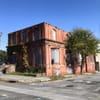Former HGAR Official Named Newburgh Deputy City Manager
Neppl is a fifth-generation Newburgh native, attorney, and a 25-year veteran of New York State government and politics.

NEWBURGH—While Orange County is in the midst of a solicitation for two storied properties on Grand Street here, the City of Newburgh has issued a Request for Proposals on Aug. 24 for developers to redevelop the iconic City Club Building at 120 Grand St.
The Mayor’s Strategic Economic Development Advisory Committee, in coordination with the City of Newburgh’s Office of Planning and Development, issued the RFP for the iconic City Club Building located in the heart of Newburgh’s East End Historic District. Built between 1852 and 1857, the distinctive brick and sandstone building, which was designed by Andrew Jackson Downing and Calvert Vaux, was originally built as the home/office of Dr. William Culbert. Dr. Culbert authored one of the first textbooks on homeopathy published in the United States.
Upon Dr. Culbert’s death in 1890, the building was purchased by Clayton and Charity Sweet, owners of the Sweet-Orr Overall Manufacturing Co., which had relocated its headquarters and much of its factory production to Newburgh. The Sweets sold the building in 1904 to the Newburgh City Club (of which Sweet was a member), a social organization catering to the city’s leading businessmen and politicians. In 1909, local architect Frank Estabrook seamlessly blended a large addition—tripling the size of the building—with the façade of the original residence. The greatly enlarged building not only housed the City Club (and its legendary basement bowling alley), but was also home to the county law library, family court lawyers, and a title search company, according to the RFP.
In the 1970s, it was purchased and renovated by private developer Brian Thompson, who rehabilitated several homes and apartment buildings in the city’s East End Historic District. Thompson succeeded in restoring the building, only to see that work go up in smoke when the property was devastated by a fire in 1981.
According to the RFP, the damaged City Club property was sold and resold throughout the intervening decades. In 1997, hopes were raised once more that the building would be resurrected. New owner Gerry Sanchez, president of the Polonia Development Corp., promoted converting the first floor into a café with the “world’s largest magazine store,” housing more than 10,000 periodical titles. The restoration never occurred and the City of Newburgh reclaimed the building, this time through an In Rem (tax foreclosure) action in 2016.
The City of Newburgh stated it is seeking a developer “with the imagination, means, and experience to return this truly exceptional building to useful life while balancing the city’s need for projects that advance equitable economic development.”
In terms of possible future uses, the city outlined a host of potential development scenarios in the RFP.
“For this project, the city is particularly interested in proposals that align with the city’s broader strategic economic growth and development priority areas. These include, but are not limited to, projects that promote sustainable growth and development in the city’s:
• Hospitality and tourism sector;
• Creative and applied arts, including maker spaces, historic and modern trades, crafts, tech and design sector;
• Class A Office Space;
• Mixed use/mixed income property inventory.”
Since the City Club is situated within the City of Newburgh’s East End Historic District, the building may be eligible for the New York State Rehabilitation Tax Credit Program, which is used in conjunction with the Federal Historic Preservation Tax Incentive. The tax credits are intended to provide owners with a financial incentive to rehabilitate a building in a manner that retains its historic characteristics. Owners can take advantage of credits on both state and federal income taxes, each providing 20% tax credits, for a combined total of 40% tax credits, for Qualified Rehabilitation Expenditures (QRE).
The RFP is available for viewing at the Planning & Development’s departmental page on the City of Newburgh’s website: https://www.cityofnewburgh-ny.gov/planning-development/pages/rfqs-request-for-qualifications-rfps-request-for-proposals.
Responses to the RFP for the more than 7,000-square-foot property must be submitted by Friday, Oct. 23, 2020, at 3:00 p.m.
Questions from potential respondents should be directed, in writing, to the Office of Planning and Development: planning@cityofnewburgh-ny.gov
Orange County sent out an RFP earlier this summer for the former YMCA, Masonic Temple and American Legion buildings. The county acquired the Newburgh properties in the hopes of expanding SUNY Orange’s services to those properties in December 2013. The deadline for submittal of proposals for one, two or three of the county-owned buildings at 48, 54 and 62 Grand St. was July 30.
Receive original business news about real estate and the REALTORS® who serve the lower Hudson Valley, delivered straight to your inbox. No credit card required.